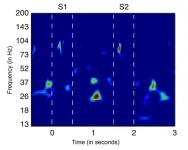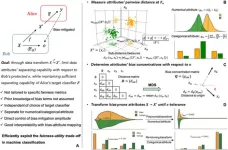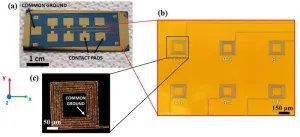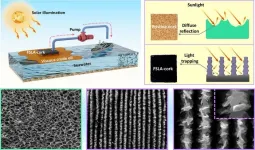Smoking cessation before laryngeal cancer treatment improves survival, retention of voice box, study shows
2024-04-23
(Press-News.org) In a study of patients who smoked when they were diagnosed with laryngeal cancer, those who quit smoking before starting chemotherapy or radiation responded better to treatment, were less likely to need their voice boxes surgically removed, and lived significantly longer than those who continued to smoke. The research, from the University of Oklahoma, is published in the journal Otolaryngology-Head and Neck Surgery.
The study’s lead author, Lurdes Queimado, M.D., Ph.D., said the findings underscore the importance of integrating tobacco cessation programs into treatment plans for cancer of the larynx, an area of the throat involved in breathing, swallowing and talking. An abundance of research exists showing that smokers fare worse with laryngeal cancer than those who never smoked or who quit before receiving a diagnosis. But Queimado narrowed her analysis to understand what happened to people who quit smoking between the time of their diagnosis and the start of treatment, typically a period of just a few weeks.
“To the best of our knowledge, this is the first study to suggest that in newly diagnosed laryngeal cancer patients who are smokers at the time of diagnosis, those who quit before treatment begins will have a much better prognosis than those who continue smoking,” said Queimado, a professor of otolaryngology-head and neck surgery in the OU College of Medicine. “We are excited about these findings because it gives our patients some hope. If chemotherapy and radiation don’t work, they may need to have their voice box removed, and that often brings stigma and depression. Their quality of life significantly decreases because they have a lot of difficulty swallowing and have to talk through a tube.”
Queimado’s research team analyzed data of patients with laryngeal cancer who were treated at OU Health Stephenson Cancer Center, Oklahoma’s only National Cancer Institute-designated cancer center. Those who quit smoking before starting treatment were nearly four times as likely as smokers were to have a complete response to chemotherapy and radiation, meaning doctors could find no evidence of cancer.
The research team then studied patient data for seven years following treatment. Those who quit smoking before treatment were half as likely as smokers to require surgery to remove their voice box in order to eradicate the cancer. In addition, those who quit smoking before treatment lived longer than those who continued to smoke. At the three-year point following treatment, 83% of those who quit smoking were still living, vs. 66% of those who continued to smoke. At five years, the statistics were 79% vs. 60%, and at seven years, 75% vs. 56%.
“To have such an improved quality of life for seven years is significant. In most patients, we treat with chemotherapy and radiation first to try to spare the voice box because it is so vital for speaking and swallowing. Because of those quality of life issues, the impact of this study is beyond what we measured,” said Queimado, who also directs the Tobacco Regulatory Science Lab in the TSET Health Promotion Research Center, a program of OU Health Stephenson Cancer Center.
Queimado has now launched a prospective study, following the outcomes of current patients who quit smoking at diagnosis and those who continue to smoke. She is also working with her clinical colleagues to place her findings on informational cards in patient care areas. However, her longer-term goal is to make tobacco cessation help much more accessible for patients.
“We are applying for a grant that would allow us to take tobacco cessation products and assistance directly to the patient rather than simply pointing them toward resources,” she said. “A diagnosis of cancer is overwhelming, and people’s lives are turned upside down, so unless services are taken to them, they are less likely to pursue them on their own. It is very difficult to quit smoking, but I think it will make a difference if we can surround the patient with the support and tools they need to quit. And if they quit during their treatment, maybe they will never go back to it.”
###
About the project
This research was supported by the National Cancer Institute, the Oklahoma Center for Advancement of Science and Technology, and the Oklahoma Tobacco Settlement Endowment Trust. In addition, Queimado holds a Presbyterian Health Foundation Endowed Chair in Otorhinolaryngology. The paper’s first author was Matthew Kurtz, M.D., a resident in otolaryngology-head and neck surgery at the OU College of Medicine. The paper is at https://doi.org/10.1002/ohn.567
About the University of Oklahoma
Founded in 1890, the University of Oklahoma is a public research university located in Norman, Oklahoma. As the state’s flagship university, OU serves the educational, cultural, economic and health care needs of the state, region and nation. OU was named the state’s highest-ranking university in U.S. News & World Report’s most recent Best Colleges list. For more information about the university, visit www.ou.edu.
END
ELSE PRESS RELEASES FROM THIS DATE:
2024-04-23
ALBUQUERQUE, N.M. — Sandia National Laboratories and the Kansas City National Security Campus completed a crucial weapons component development milestone, prior to full rate production.
The Mark 21 Replacement Fuze interfaces with the W87-0 warhead for deployment onto the Minuteman III and, eventually, the Sentinel Intercontinental Ballistic Missile.
The first production unit of the replacement fuze was approved through the National Nuclear Security Administration’s rigorous Quality Assurance Inspection Procedure ...
2024-04-23
WASHINGTON, D.C. – The Patient-Centered Outcomes Research Institute (PCORI) today announced the approval of funding awards totaling more than $150 million to support new patient-centered comparative clinical effectiveness research (CER) studies, research to strengthen the rigor and quality of patient-centered CER and a project to implement the findings of PCORI-funded research into practice.
Among the nine awards for patient-centered CER, two include support for large, two-phased trials comparing approaches to treatments for heart failure and asthma. Two other large studies will compare health system strategies to improve hypertension control, and another will evaluate ...
2024-04-23
Human beings are likely to adopt the thoughts, beliefs, and behaviors of those around them.
Simple decisions like what local store is best to shop at to more complex ones like vaccinating a child are influenced by these behavior patterns and social discourse.
“We choose to be in networks, both offline and online, that are compatible with our own thinking,” explained Amin Rahimian, assistant professor of industrial engineering at the University of Pittsburgh Swanson School of Engineering. “The social contagion of behavior through networks can help ...
2024-04-23
In a new study published in Nature Chemistry, UNC-Chapel Hill researcher Ronit Freeman and her colleagues describe the steps they took to manipulate DNA and proteins — essential building blocks of life — to create cells that look and act like cells from the body. This accomplishment, a first in the field, has implications for efforts in regenerative medicine, drug delivery systems, and diagnostic tools.
“With this discovery, we can think of engineering fabrics or tissues that can be sensitive to changes in their environment and behave in dynamic ways,” says Freeman, whose lab is in the Applied Physical Sciences Department of the UNC College ...
2024-04-23
To properly protect forests and evaluate the state of natural resources, conservation practices and environmental policies, it is important to have accurate information on an area’s forest extent. One of the challenges facing researchers when it comes to evaluating the accuracy of forest extent, however, is that models use different remote sensing products that may have different definitions for what determines forest extent. In addition, on the ground surveys may sometimes come into conflict with what remote, satellite-based products are describing as forests.
To help quantify this problem, a group of researchers from ...
2024-04-23
The brain processes information on many scales. Individual cells electrochemically transmit signals in circuits but at the large scale required to produce cognition, millions of cells act in concert, driven by rhythmic signals at varying frequencies. Studying one frequency range in particular, beta rhythms between about 14-30 Hz, holds the key to understanding how the brain controls cognitive processes—or loses control in some disorders—a team of neuroscientists argues in a new review article.
Drawing on experimental ...
2024-04-23
We use computers to help us make (hopefully) unbiased decisions. The problem is that machine-learning algorithms do not always make fair classifications, if human bias is embedded in the data used to train them — which is often the case in practice. To ease this "garbage in, garbage out" situation, a research team presented a flexible framework for mitigating bias in machine classification. Their research was published Apr. 8 in Intelligent Computing, a Science Partner Journal.
Existing attempts to mitigate classification bias, according to the team, are often held back by their reliance on specific metrics of fairness and predetermined ...
2024-04-23
In the nine decades since humans first produced fusion reactions, only a few fusion technologies have demonstrated the ability to make a thermal fusion plasma with electron temperatures hotter than 10 million degrees Celsius, roughly the temperature of the core of the sun. Zap Energy’s unique approach, known as a sheared-flow-stabilized Z pinch, has now joined those rarefied ranks, far exceeding this plasma temperature milestone in a device that is a fraction of the scale of other fusion systems.
A new research paper, published this month in Physical ...
2024-04-23
WASHINGTON, April 23, 2024 — Neural stimulation is a medical technique used to treat many illnesses affecting the nervous system. It involves applying energy to neurons to encourage them to grow and make connections with their neighbors. Treatments for epilepsy can often include neural stimulation, and similar treatments exist for Parkinson’s disease, chronic pain, and some psychiatric illnesses.
In the Journal of Vacuum Science & Technology A, by AIP Publishing, researchers from the University of Minnesota deployed an array of microscopic coils — microcoils — to create ...
2024-04-23
WASHINGTON, April 23, 2024 – Oil spills are deadly disasters for ocean ecosystems. They can have lasting impacts on fish and marine mammals for decades and wreak havoc on coastal forests, coral reefs, and the surrounding land. Chemical dispersants are often used to break down oil, but they often increase toxicity in the process.
In Applied Physics Letters, by AIP Publishing, researchers from Central South University, Huazhong University of Science and Technology, and Ben-Gurion University of the Negev used laser treatments to transform ordinary ...
LAST 30 PRESS RELEASES:
[Press-News.org] Smoking cessation before laryngeal cancer treatment improves survival, retention of voice box, study shows










